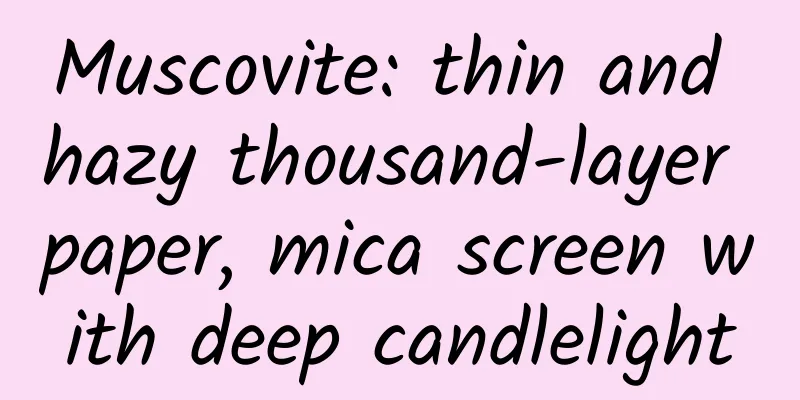Muscovite: thin and hazy thousand-layer paper, mica screen with deep candlelight

|
This issue introduces a white mica specimen from Ontario, Canada. The white mica on the specimen has a regular shape and is stacked up like a book. The specimen is collected in the Earth Science Museum of Kunming University of Science and Technology and is a world-class rock and mineral specimen. Muscovite is a potassium aluminum silicate mineral, belonging to the monoclinic system, with a layered structure inside. The chemical composition is widely replaced by isomorphous substances, and common admixtures include: Ba, Na, Rb, Fe3+, Cr, V, Fe2+, Mg, Li, Ca, F, etc., forming a variety of component variants, such as barium muscovite, chrome mica, etc.; sericite refers to small scaly muscovite. Muscovite is generally in the form of plates or flakes, with a pseudo-hexagonal or rhombus shape, and has obvious horizontal stripes on the column surface. Small crystals are scaly, and large ones can cover an area of several square meters. Pictured is muscovite from Ontario, Canada Muscovite is colorless, and most of them contain impurities and are light yellow, brown, gray, light green, light red, etc. The color change is mainly caused by isomorphous inclusions. Sometimes it presents black and brown spots due to the inclusion of magnetite and hematite. Muscovite is transparent to translucent, and has a set of extremely complete cleavages. It can be peeled into elastic flakes layer by layer with a knife or fingernail. It has a glassy luster and pearly luster on the cleavage surface. The hardness is 2-3 in the direction parallel to the extremely complete cleavage plane and 4 in the vertical direction. The relative density is 2.76-3.10. Muscovite is one of the widely distributed rock-forming minerals, which can be formed under different geological conditions. Muscovite often appears in metamorphic schists and gneisses. Mudstone can form sericite during low-grade regional metamorphism, and become muscovite when the degree of metamorphism is slightly higher. Muscovite can be generated in the late stage of acidic magma crystallization and the pegmatism stage. Muscovite produced in granite pegmatites often forms crystals with high industrial value. Muscovite also appears in the sericiteization in hydrothermal alteration, while sericiteization in medium and low temperature alteration forms a large amount of sericite. After weathering and crushing, muscovite can become debris in clastic sediments, and can be transformed into hydromica and kaolinite when weathering is strong. Pictured is muscovite mica (in flake form) from Ontario, Canada Mica is also known as "mica stone", "thousand-layer paper", "silver stone", etc. In ancient my country, mica was used to make screens, transparent windshields for windows and lanterns, and other home decorations. It has the advantages of light transmission but no shadow, privacy and transparency. The "mica screen" in the poem "your family's mica screen, sometimes open to the wild courtyard" refers to the mica screen. In Qianjin Fang, mica stone is used as a traditional Chinese medicine, also known as silver stone. After processing for internal and external use, it has the effects of improving eyesight, stopping diarrhea, nourishing the kidney and cold, calming the five internal organs, and removing dead muscles. Muscovite is characterized by insulation, high temperature resistance, stable physical and chemical properties, good thermal insulation, elasticity and toughness. In industry, muscovite is widely used in daily chemical raw materials, mica ceramic raw materials, paint additives, plastic and rubber additives, building materials, protective layers for welding rod coatings, drilling mud additives, insulation materials for electrical equipment and electrical equipment, and in the manufacture of steam boilers, furnace windows for smelting furnaces and mechanical parts. Pictured is a detail of muscovite from Ontario, Canada. In the world of mineral specimen collection, muscovite can be seen in many exquisite and precious specimens, but it often appears as a "supporting mineral". In many specimens, flaky muscovite aggregates can often make the main mineral more exquisite and gorgeous. Muscovite is produced all over the world, with major production areas including Australia, Bolivia, Brazil, Chile, Canada, China, France, Norway, Russia, Slovakia and the United States. Written by: Zhu Jun, Shen Cen, Wang Lei Scientific Advisor: Zhang Shitao Photographed by: Yang Yuchen Poster: Jung Pil-yoon Supporting institution: College of Land and Resources Engineering, Kunming University of Science and Technology |
<<: The roasted lamb in Kashgar is so delicious!
>>: Wild watermelon seedlings are neither watermelons nor seedlings.
Recommend
Fly high into the sky and see the green mountains and clear waters on earth!
On August 4, the world's first forest carbon ...
The end of live show monetization?
Regulators take measures to regulate live broadca...
These people who are admitted to the hospital are all because of the air conditioner! In the dog days of summer, this is how to use the air conditioner without harming your health
Since the beginning of summer, there have been ro...
Urgent reminder again! Don't take photos of these bugs
During the past May Day holiday The most popular ...
Google's return to China: Who is optimistic, who is pessimistic, who is panicking, and who is looking forward to it?
In February 2016, Google will officially return t...
6 little-known facts about WeChat that you may not know yet, each of which makes you regret not knowing it earlier
[[391706]] 01Batch detection of true and false fr...
Case sharing: How to use red envelope fission promotion to increase APP downloads?
The gameplay of the expanding red envelope is ver...
Case study of making money through SEO of regional websites for confinement nanny and housekeeping services!
As long as you have some experience in making mon...
Popular Science | When hot water and cold water are put into the refrigerator together, why does the hot water freeze first?
If a cup of hot water and a cup of cold water are...
Do you want to soak your mouth in salt water when you prick your pineapple? No, this is a better way
"If you eat pineapple, your mouth will sting...
How to quickly increase followers on Xiaohongshu?
Today I want to talk about a hot topic, as the ti...
The way B station’s information flow ads go viral
The "Most Beautiful Night of 2019" New ...
How much does it cost to make a Suzhou women's clothing mini program? What is the quotation for the production of Suzhou women's clothing mini program?
How much does it cost to produce the Suzhou women...
A case study on efficient advertising and customer acquisition optimization in the beauty industry!
With the development of society, the growth momen...
Content: Social media promotion and communication routines
The verbs most commonly associated with traffic a...









